Crab rolls are a delicious and iconic seafood sandwich found throughout coastal regions of the United States. Their incredible flavors and textures have made them a staple menu item at seafood shacks and restaurants across New England, the Mid-Atlantic, the Gulf Coast, and beyond.
But what exactly makes up a crab roll? While recipes can vary slightly by region, most crab rolls contain a few core ingredients that define this sandwich.
The Main Components of a Crab Roll
The star of any crab roll is, of course, the crab meat itself. Freshly cooked and picked crab meat provides the sweet, delicate flavor and tender chunks that make these sandwiches so enjoyable.
Common types of crab used include:
-
Blue crab – Popular in the Chesapeake Bay region and Gulf Coast Provides a sweet, briny flavor
-
Dungeness crab – Common on the Pacific Coast. Offers a sweeter, lighter flavor.
-
Jonah crab or rock crab – Found in New England. Has a rich, salty, and buttery taste.
The crab meat is typically mixed with mayonnaise or aioli, which helps bind it together while adding a creamy texture. Only a small amount is used – just enough to lightly coat the crab.
From there, crab roll recipes branch out with various seasonings and additional ingredients. Here are some of the most common:
- Lemon juice – Brightens up the flavors with acidity
- Celery – Adds crunch
- Onion or chives – Offers subtle aromatic notes
- Old Bay seasoning – Provides warmth through spices like paprika, oregano, and red pepper
- Salt and pepper
- Butter – Enriches the crab’s natural sweetness
The dressed crab mixture is served on a buttered and toasted split-top bun. Popular options include New England-style hot dog buns or soft potato rolls. This cradles the filling while offering a perfect contrast of textures.
Finally, crab rolls are often served with lemon wedges, pickles, potato chips, or french fries on the side. This completes the classic seafood shack experience.
Regional Variations to Enjoy
While the basic components stay mostly consistent, crab rolls take on regional flair in different parts of the U.S. Trying the local version is a great way to savor the sandwich.
New England crab rolls emphasize simplicity. They contain minimal ingredients like crab, lemon butter, and parsley or chives in a grilled bun This allows the natural crab flavors to shine
Mid-Atlantic crab rolls highlight seasoning like Old Bay. Celery and egg are also common additions. The crab salad leans creamier compared to New England.
Gulf Coast crab rolls feature Creole or Cajun spices. Pepper sauces, hot sauce, cayenne, paprika, and other lively flavors give it a kick.
On the West Coast, Dungeness crab shines in rolls with garlic, avocado, chili, and herb aiolis. Crisp cool toppings like cucumber balance the richness.
There are also global twists like Japanese crab salad rolls with kewpie mayo, cucumber, and avocado, or Peruvian crab salad sandwiches served with fried yucca and spicy aji sauce. The possibilities are endless!
How to Assemble the Perfect Crab Roll at Home
Making delicious crab rolls at home is easy with a few simple tips:
-
Use high-quality lump or jumbo lump crab meat. This will give you those coveted big, tender chunks in each bite. Avoid cheaper shredded crab meat fillers.
-
Go light on the mayo. You just need enough to lightly bind and moisten the crab salad without drowning it.
-
Toast the buns for a contrasting crunch. Butter them for extra richness. Brioche rolls also work wonderfully.
-
Keep seasonings simple to let the crab shine. Lemon, parsley or chives, Old Bay, celery, and parsley are perfect choices.
-
Gently fold the crab salad so the chunks don’t get crushed. You can sprinkle with extra lemon juice and seasoning after folding to evenly coat.
-
Pile the crab salad generously into the bun, mounding it high so every bite is packed with crab.
-
Serve immediately for the best texture and flavor. The bun won’t get soggy and the crab stays chilled.
-
Pair with lemon wedges, pickles, and chips for the complete experience. Enjoy!
With a few basic techniques and quality ingredients, it’s easy to create amazing crab rolls at home. Once you master the basics, you can start experimenting with fun regional twists.
Why Crab Rolls Are Such a Beloved Seafood Sandwich
There are so many reasons crab rolls have become a sensation and seaside classic:
-
The sweet, delicate flavor of fresh crab meat shines when kept simple.
-
They offer the perfect blend of rich crab, creamy dressing, and crunchy toastiness.
-
They make a satisfying, mess-free sandwich you can eat with your hands.
-
They embody the laidback, beachside seafood shack dining experience.
-
Regional variations let you sample local flavors and styles.
-
They are easy to make at home for a taste of vacation wherever you live.
Crab rolls distill the very essence of summer by the sea into one incredible sandwich. Their simplicity highlights the joy of fresh seafood at its best. Whether enjoying local crab rolls on vacation or a homemade version at home, this iconic sandwich is a cherished treat.
So next time you’re craving a delightful bite of ocean flavors, give the classic crab roll a try. It won’t take long to discover why these have been favorites for generations along America’s coastlines. Dig in and savor the flavors!

What you need to make this creamy crab sushi roll:
Makes 1 large sushi roll
- 2 legs of imitation crab OR 1/2 cup crab meat – shredded or diced
- 1 tablespoon softened cream cheese
- 1 tablespoon mayo
- 1/4 of a cucumber – cut into long thin strips
- 1 teaspoon sriracha – optional
- 1 cup cooked sushi rice – cooled
- 1 nori wrap – if using a full size sheet, cut 3/4ths of the wrapper and set aside the other 1/4 of it to make a standard sized roll.
- Spicy mayo
- Eel or unagi sauce
OR this sauce mixture can be used as a substitute for eel sauce.
- 2 tablespoons dark soy sauce or regular soy sauce
- 2 teaspoons oyster sauce
- Pinch of sugar
- French fried onions
- Sesame seeds
- Lay down sushi rice on plastic wrap, press down, cover top o rice with plastic wrap and use rolling pin to press rice so its thin and uniform to fit the nori wrap size and shape.
- Add the seaweed rough side down.
- Shred the imitation crab or real crab meat or chop it and add to a small bowl.
- Add cream cheese and mayo to crab and mix around until crab is coated and creamy.
- Add crab salad down the middle of the nori wrap followed by the cucumber slices.
- Drizzle a little sriracha down the middle of the roll if using it.
- Close roll by bringing the ends together to close and form a cylinder, it’s okay if the ends overlap, press together with your hands then use a sushi mat or towel to help press and form the sushi roll.
- Cut off the loose ends off, then slice with a water or rice vinegar coated serrated knife by slowly and gently sawing through each slice, re-dipping the knife if rice starts to stick to it.
- Add sauces and toppings if desired on top and enjoy.
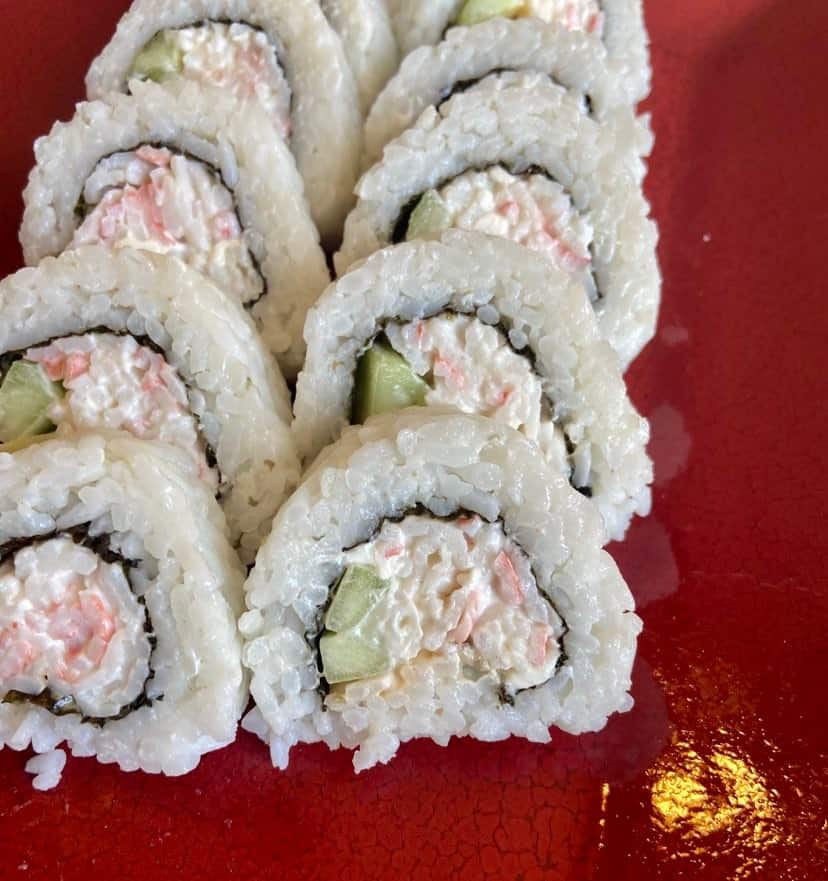

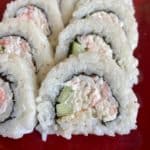

How do I roll a sushi roll with the rice on the outside?
Rolling sushi with the rice on the outside may seem intimidating but I have a few tips and tricks that makes things easy and stress free. My tempura shrimp sushi roll is pictured.
First – Lay down plastic wrap on your work surface then add rice.
Second – Press down the rice with your hands the best you can in the shape of the nori seaweed wrapper, then place another piece of plastic wrap over top of the rice and use a rolling pin to compress the rice so it’s thin and evenly compressed.
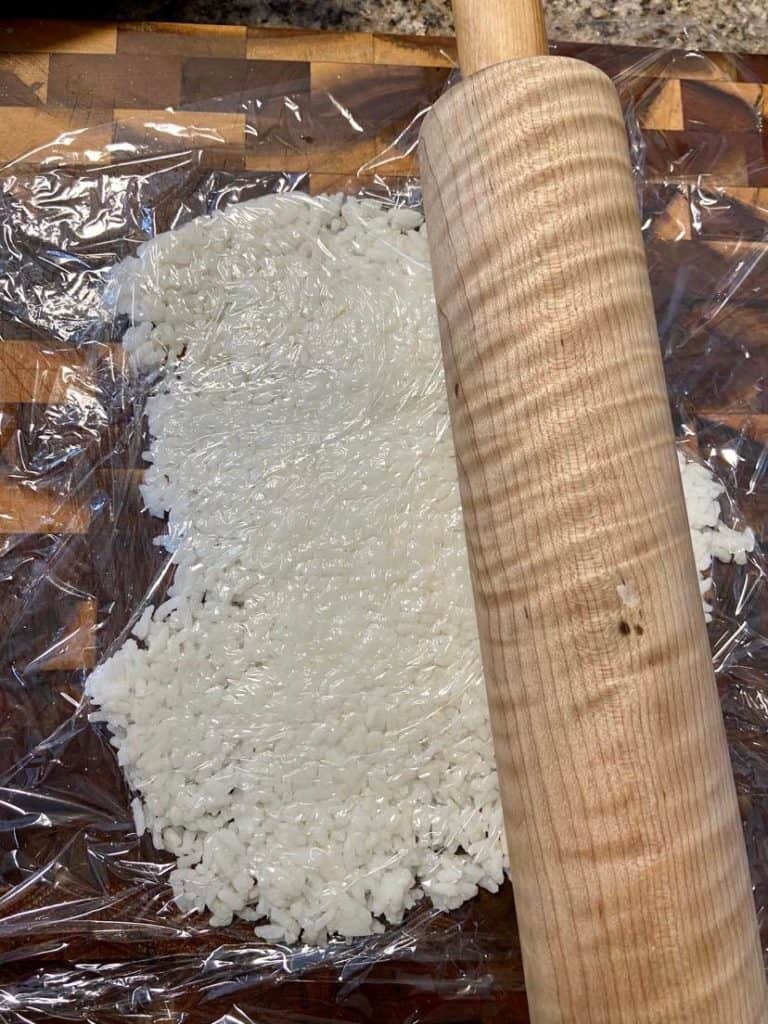

Third – Remove the plastic wrap from the top of rice. Then lay the nori seaweed wrap with the rough side down on the rice. Once it’s down, it will immediately stick to the rice. If you have any spots that need more rice, you can tuck a little rice under it the best you can.
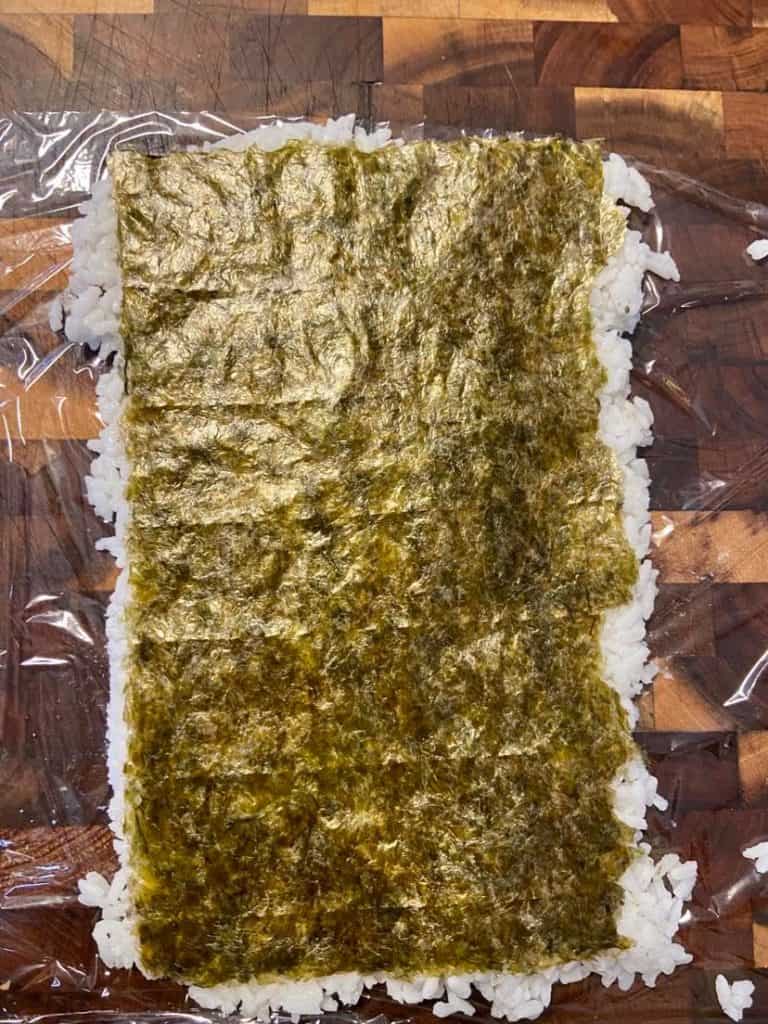

Note – if you are using a large nori sheet, cut it into 3/4th’s the size so you don’t end up with a huge roll. If you use a party sized nori wrap or smaller one you don’t need to cut it.
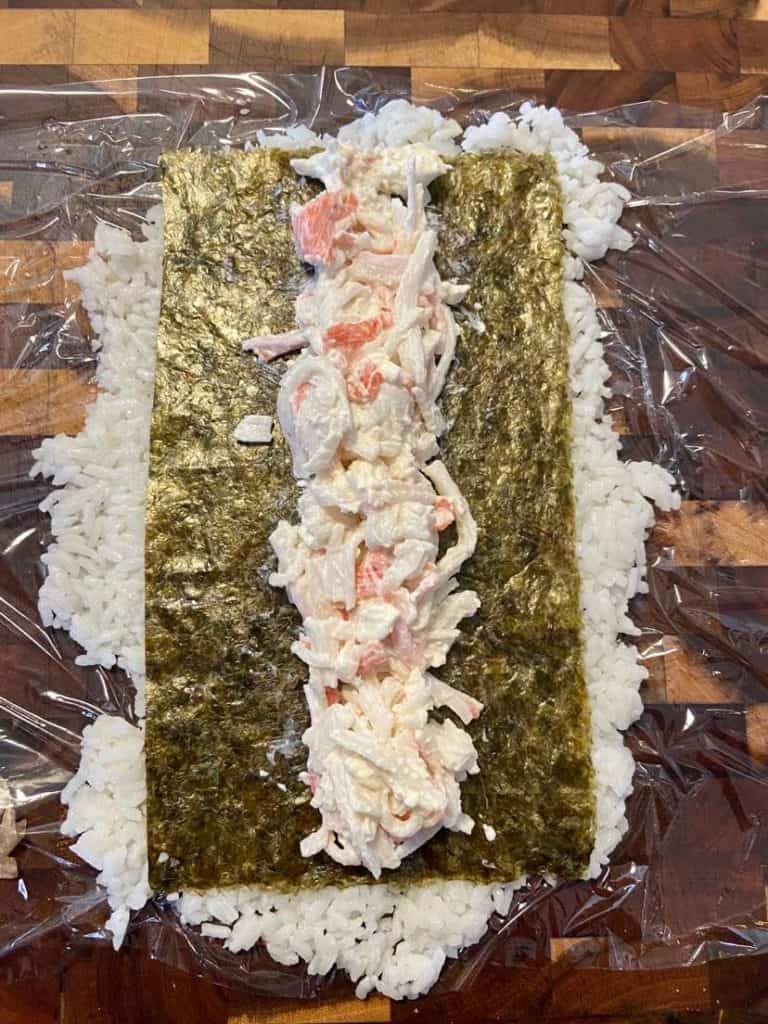

Fourth – Trim the sides of the rice around the nori, leaving a little space of rice showing.
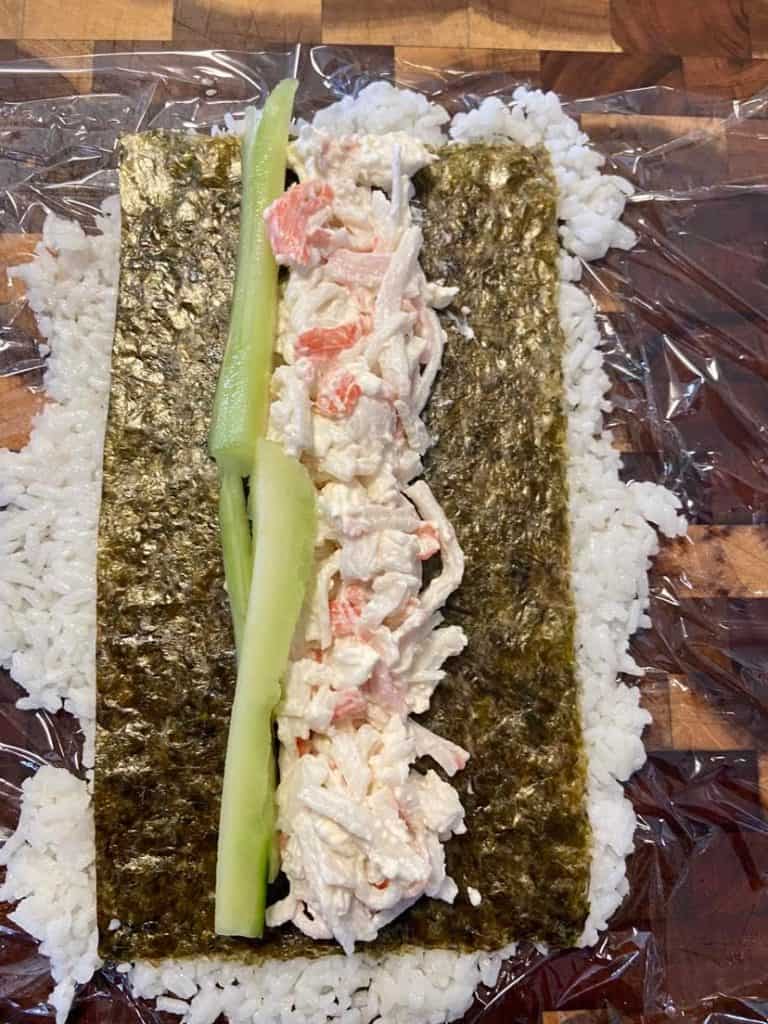

Fifth – Add filling, then lift up the sides of the plastic wrap on each side and bring roll together so the ends meet in the middle or slightly overlap. Turn roll on it’s side and with the plastic wrap still on the roll, use your hands to gently press the roll together.
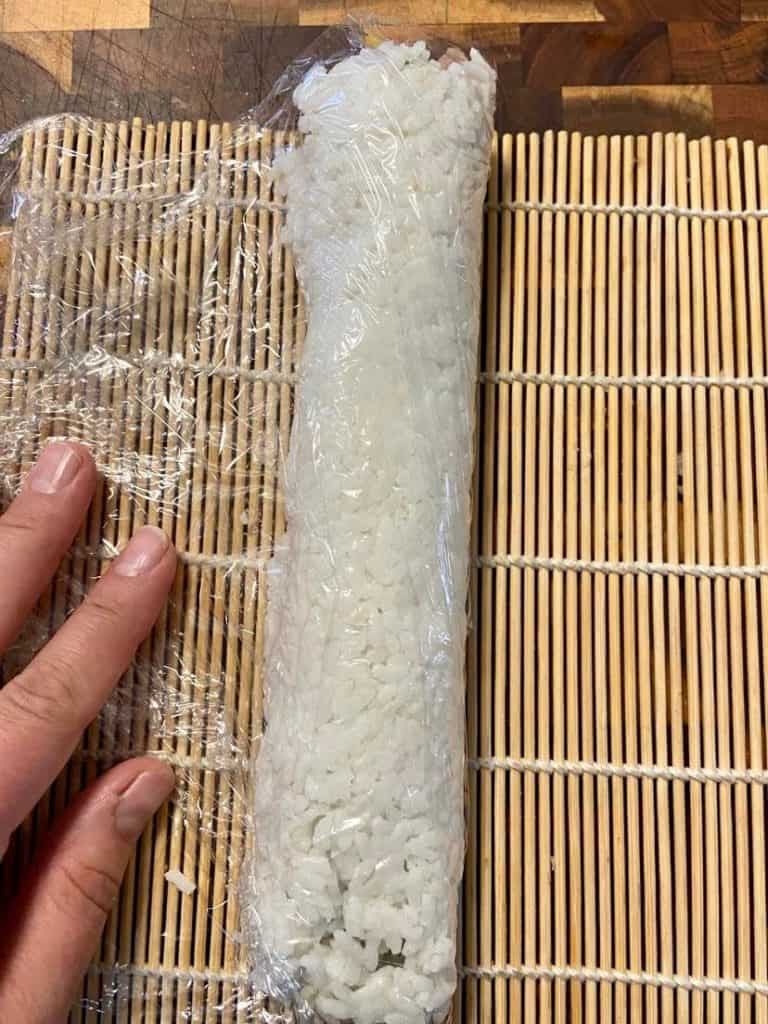

Sixth – Use a sushi mat or towel to press your roll together so it’s nicely compressed and secure. Remove plastic and trim the loose ends of the roll.
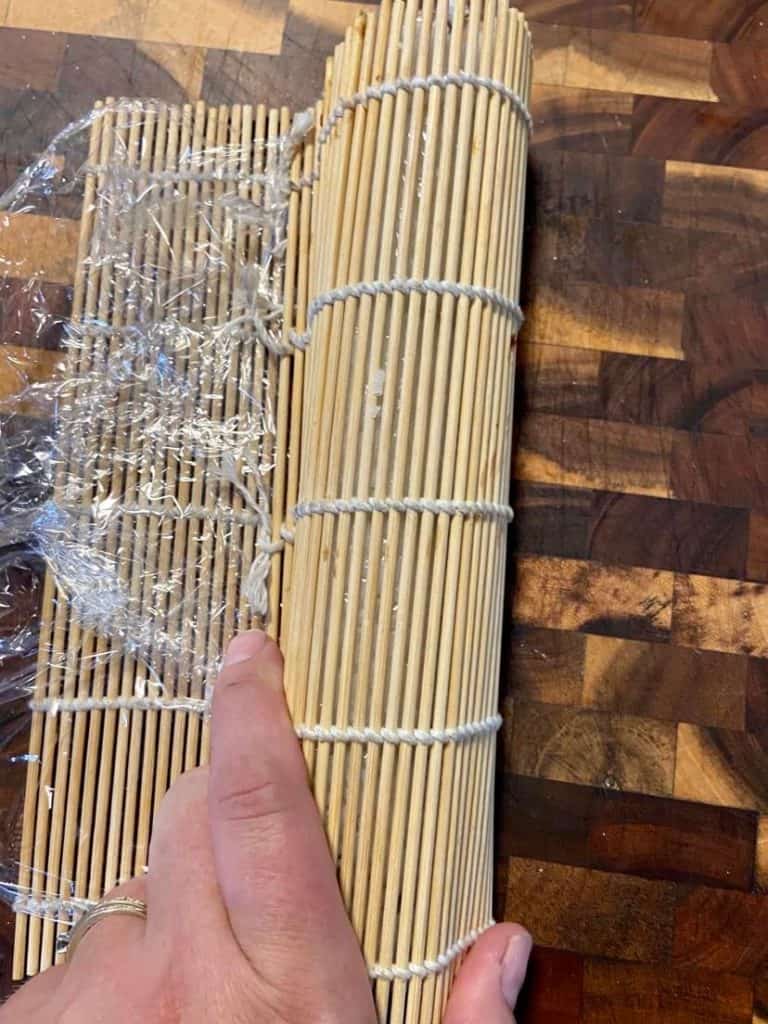

Seventh – If adding sauces and toppings you can add them now or you can slice first, again this is up to your preference.
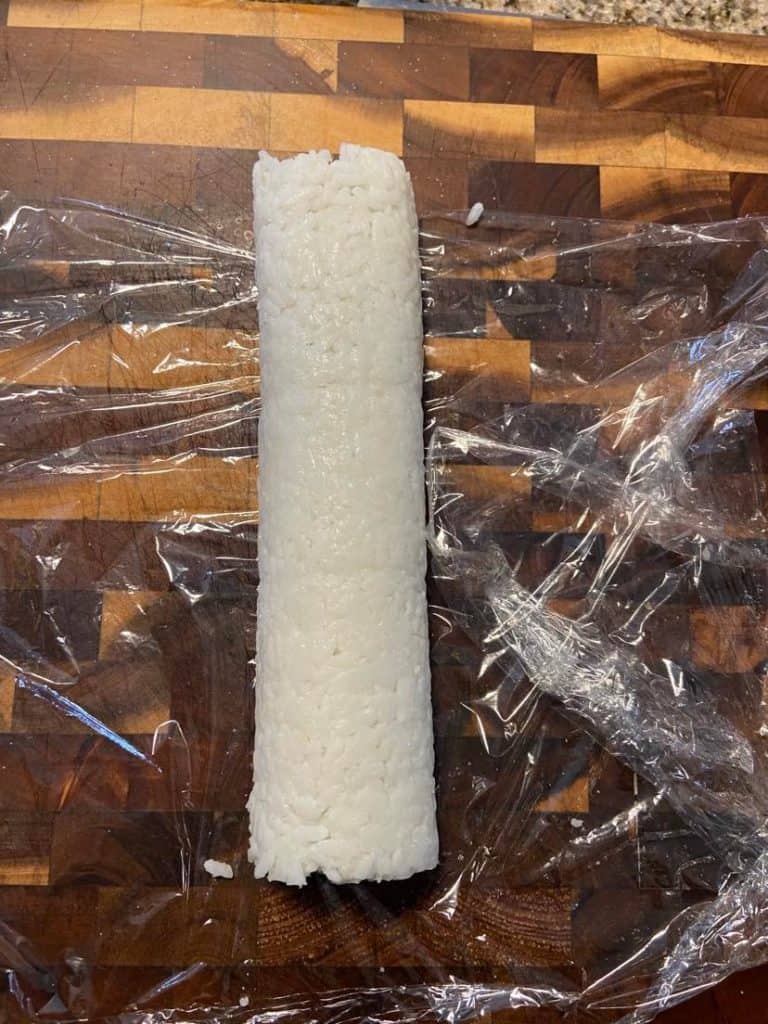

Eighth – Slicing the sushi roll can be intimidating but if you use a serrated knife that is dipped in either rice vinegar or water between each slice it is easy to do. Gently and slowly saw through the roll, so you get through the nori wrap without pulling it out and messing up your roll.
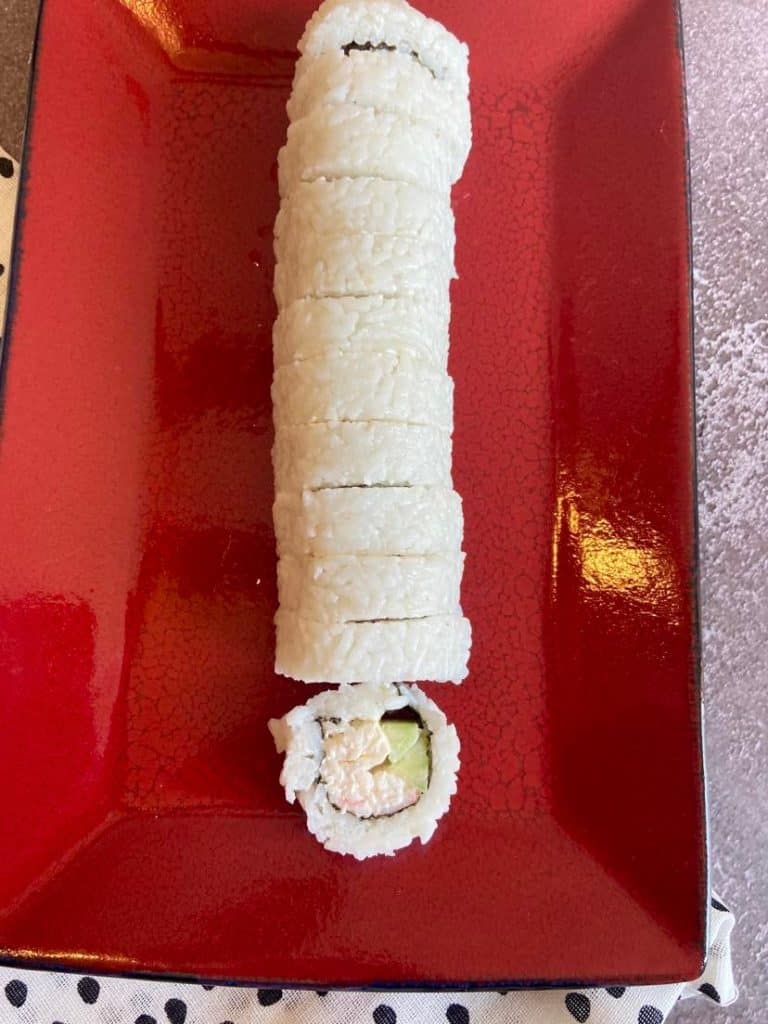

Ninth – Plate and enjoy.
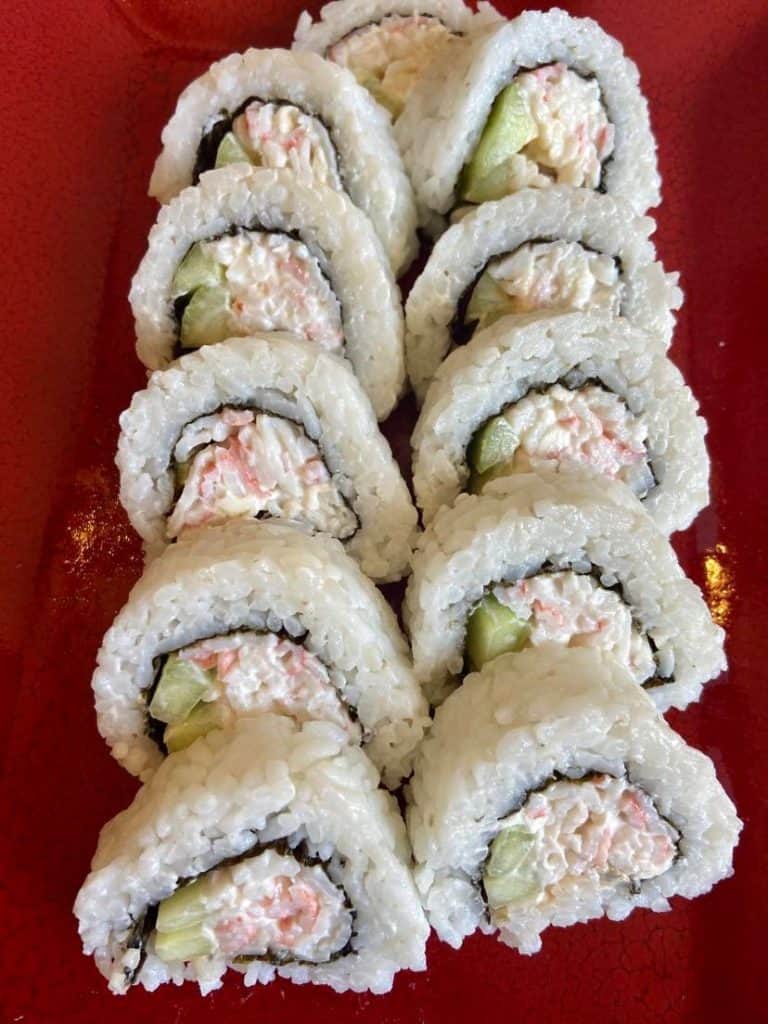

Tenth – Do it again and see how much better you get!
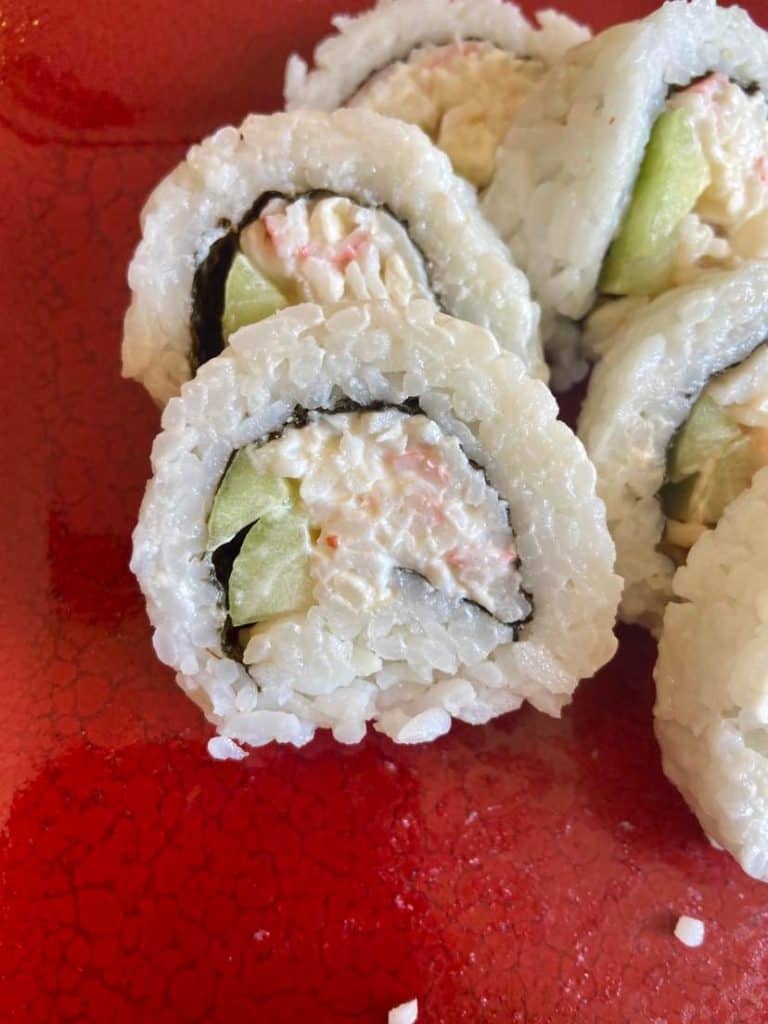

The beauty of sushi is in the creative process. I have been making sushi for years and I love it! It’s also the perfect group party activity. I love seeing what everyone creates and trying all of the different creations.
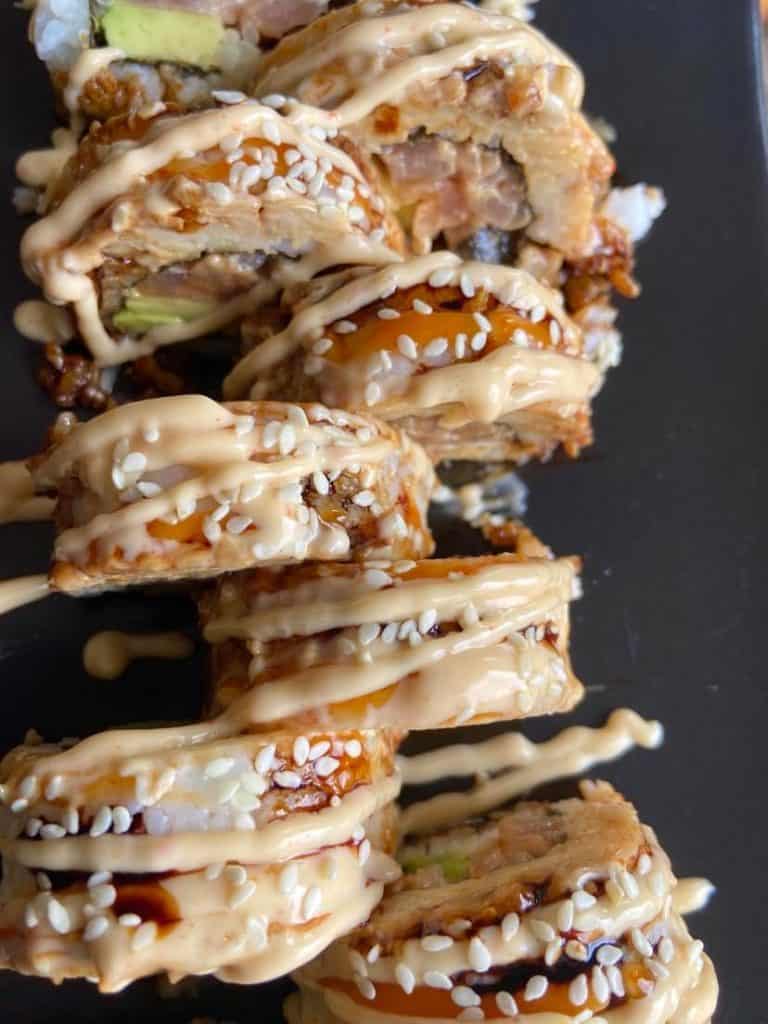

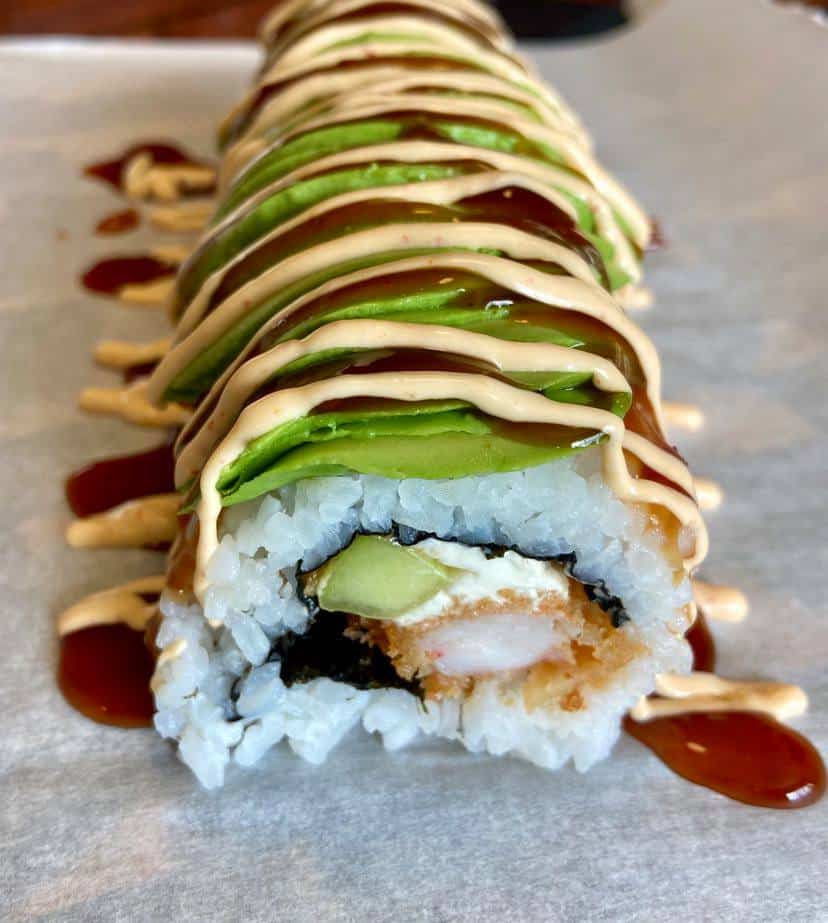

Making a snow crab roll is easy !!
FAQ
What are the ingredients in a crab roll?
A crab roll, also known as a crab salad roll, typically includes cooked crab meat, mayonnaise, celery, and seasonings like lemon juice, chives, and Old Bay seasoning.
Is crab salad roll healthy?
Crab salad rolls are much healthier than fried spring rolls and they look beautiful with the colors of their various ingredients showing through the delicate rice wrappers. Crab contains omega-3 fatty acids and B vitamins, and these are just a couple of the health benefits it provides.
What kind of fish is imitation crab made of?
Imitation crab, also known as surimi, is primarily made from Alaskan pollock. The fish is deboned, washed, and finely ground into a paste called surimi.
Are crab rolls cooked?
Yes, the crab in most crab rolls is cooked, especially when referring to California rolls or other sushi rolls using imitation crab meat. Imitation crab, also known as surimi, is made from processed white fish that is cooked during its preparation.
